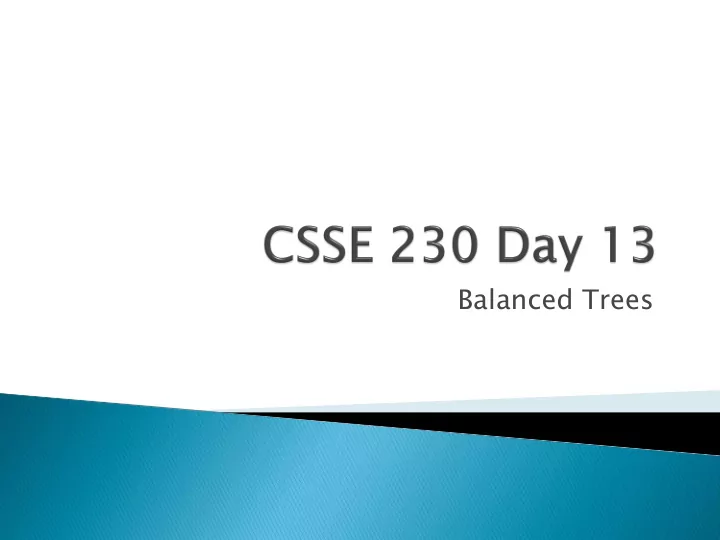

Balanced Trees
Displayable Binary Tree project was due 8 AM Written Assignment 5 due Friday 8 AM Doublets Milestone 1 also due next Friday 8 AM ◦ Aim for earlier; Milestone 1 is considerably less than the halfway point of code for the project.
Leftover Questions from Exam 1? Doublets: what's it all about? Meet your Doublets partner Another induction example Recap: The need for balanced trees Analysis of worst case for height-balanced (AVL) trees AVL tree balance after insert
Answers will vary from Welcome to Doublets, a game of "verbal torture." these! Enter starting word: flou our Enter ending word: brea read Enter chain manager (s: stack, q: queue, x: exit): s Chain: [flour, floor, flood, blood, bloom, gloom, groom, broom, brood, broad, bread] Length: 11 A Lin ink is the collection of all words that Candidates: 16 can be reached from a given word in Max size: 6 Enter starting word: we wet one step. I.e. all words that can be Enter ending word: dry ry made from the given word by Enter chain manager (s: stack, q: queue, x: exit): q substituting a single letter. Chain: [wet, set, sat, say, day, dry] Length: 6 A Chain ain is a sequence of words (no Candidates: 82651 duplicates) such that each word can be Max size: 847047 made from the one before it by a single Enter starting word: wh whe letter substitution. Enter ending word: rye The word "oat" is not valid. Please try again. A Chain ainMan anag ager stores a collection of Enter starting word: ow owner Enter ending word: br bribe be chains, and tries to extend one at a Enter chain manager (s: stack, q: queue, x: exit): s time, with a goal of extending to the No doublet chain exists from owner to bribe. ending word. Enter starting word: C Enter chain manager (s: stack, q: queue, x: exit): x Goodbye! Stac ackChai ainMan Manag ager: depth-first search Queue ueChainMana nager: breadth-first search Prio riorit ityQueueChain ainMan Manag ager: First extend the chain that ends with a word that is closest to the ending word.
Section 1: please see link from schedule page csse230-201330-doublets31,bowmasbt,ryanjm csse230-201330-doublets32,earlda,llewelsd csse230-201330-doublets33,evansda,saslavns csse230-201330-doublets34,gollivam,yeomanms, romogi csse230-201330-doublets35,heidlapt,kowalsdj csse230-201330-doublets36,jacksokb,schneimd csse230-201330-doublets37,jungckjp,havenscs csse230-201330-doublets38,lid,caoc Meet your partner, csse230-201330-doublets39,rockwotj,kanherp exchange contact csse230-201330-doublets40,lis,wuj info, plan when csse230-201330-doublets41,wadema,cookmj you can meet again. There will be in- class work time on day 14.
Q1 Q1 Recall our definition of the Fibonacci numbers: ◦ F 0 = 0, F 1 = 1, F n+2 = F n+1 + F n An exercise from the textbook Recall: How to show that property P(n) is true for all n≥n 0 : (1) Show the base case(s) directly (2) Show that if P(j) is true for all j with n 0 ≤j<k, then P(k) is true also De Details ils o of step 2 p 2: a. Write down the induction assumption for this specific problem b. Write down what you need to show c. Show it, using the induction assumption
Q2 Q2 BST algorithms are O(h(T)) Minimum value of h(T) is Can we rearrange the tree after an insertion to guarantee that h(T) is always minimized?
Q3 Q3 Height of the tree can vary from log N to N Where would J go in this tree? What if we keep the tree perfectly balanced? ◦ so height is always proportional to log N What does it take to balance that tree? Keeping completely balanced is too expensive: ◦ O(N) to rebalance after insertion or deletion rebalance Solution: Height Balanced Trees (less is more)
Q4 Q4 More precisely , a binary tree T is height balanced if T is empty, or if | | hei eight( t( T T L ) ) - hei eight( t( T T R ) | ≤ 1, and T L L and T R are both height balanced.
Q5 Q5 Is it taller than a completely balanced tree? ◦ Consider the dual concept: find the minimum number of nodes for height h. A binary search tree T is height balanced if T is empty, or if | | hei height( T T L ) ) - hei height( t( T T R ) | ) | ≤ 1, and T L L and T R are both height balanced.
Q 6 Q 6-7 Named for authors of original paper, Adelson-Velskii and Landis (1962). Max. height of an AVL tree with N nodes is: H < H < 1. 1.44 4 log ( g (N+ N+2) – 1.32 328 8 = O(log g N) N)
Q8 Q8 Why? Worst cases for BST operations are O(h(T (T)) )) ◦ find, insert, and delete h(T) T) can vary from O(log (log N N) to O(N) N) Height of a height-balanced tree is O(log (log N) So if we can rebalance after insert or delete in O(log (log N N), then all all operations are O(log (log N N)
= / \ or or or or Different representations for / = \ : Just two bits in a low-level language Enum in a higher-level language
/ Assume tree is height-balanced before insertion Insert as usual for a BST Move up from the newly inserted node to the lowest “unbalanced” node (if any) ◦ Use the ba balance c code ode to detect unbalance - how? Do appropriate rotation to balance the sub-tree rooted at this unbalanced node
For example, a single left rotation : We’ll pick up here next class…
Recommend
More recommend